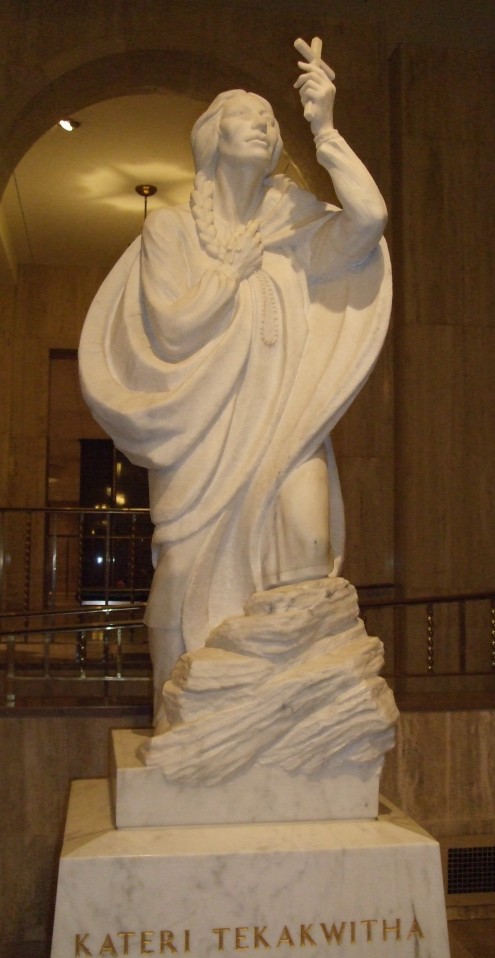
A marble statute of Blessed Kateri Tekakwitha in the the Basilica of the National Shrine of the Immaculate Conception in Washington, DC.
June 22, 1980 was the day that Kateri Tekakwitha was beatified by Pope John Paul II, and as such she is referred to as Blessed Kateri Tekakwitha within the Roman Catholic Church.
Who was Kateri Tekakwitha and what is her historical significance? Here is a condensed version from online sources.
Kateri Tekakwitha was the daughter of a Mohawk chief, Kenneronkwa, and a Catholic Algonquin woman, Kahenta, and was born in the Mohawk fortress of Ossernenon near present-day Auriesville, NY. Her mother was baptized and educated by the French like many of the Abenaki but was captured there at the start of a war with the Iroquois and taken to Kenneronkwa’s homeland. When Kateri was four, smallpox swept through the tribe, and Tekakwitha was left with unsightly scars on her face and poor eyesight. This outbreak took the lives of both her parents, Kahenta (Flower of the Prairie) and Kenneronkwa (Beloved) and her brother. She was then adopted by her uncle, who was a chief of the Turtle Clan. As the adopted daughter of the chief, many young men sought her hand in marriage, in spite of her disfigured face. But she realized that this was only for political purposes and was disgusted by the idea of marriage. However, during this time she began taking an interest in Christianity. Her mother was Christian and had given Kateri a rosary but her uncle had taken it away and encouraged her not to become Christian. She was headstrong and decided that since she was cast away from Mohawk society, she would join another.
In 1666 Kateri’s clan settled on the north side of the Mohawk River, near what is now Fonda, NY. While living here, at the age of 20, Tekakwitha was baptized on Easter Sunday, April 18, 1676 by a Jesuit priest. At her baptism, she took the name “Kateri,” a Mohawk pronunciation of the French name “Catherine”. Tekakwitha literally means “she moves things.”
Unable to understand her zeal, members of the tribe often chastised her, which she took as a testament to her faith. Kateri exercised physical mortification as a route to sanctity. She would occasionally put thorns upon her mat and lie on them, all the while praying for the conversion and forgiveness of her kinsmen. Piercing the body to draw blood was a traditional practice of the Hurons, Iroquois as well as the Mohawks. Kateri believed that offering her blood was in imitation of Christ’s crucifixion. In this, Kateri was just continuing traditional tribal ways. She changed this practice to stepping on burning coals when her close friend, Marie Therese, and her confessor expressed their disapproval. Because she was persecuted by her Native American kin, which included threats to her life, she fled to an established community of Native American Christians in Kahnawake, Quebec, where she lived a life dedicated to prayer, penance, and care for the sick and aged. In 1679, she took a vow of chastity, as in the Catholic expression of consecrated virginity. A year later, on April 17, 1680, Kateri died at the age of 24. Her last words are said to be, “Jesus, I love You!”
Tradition holds Kateri’s scars vanished at the time of her death revealing a woman of immense beauty. It has been claimed that at her funeral many of the ill who attended were healed on that day. It is also held that she appeared to two different individuals in the weeks following her death.
The process for her canonization began in 1884. The first miracle attributed to her intercession was a case where bad facial ring worms were miraculously cured. She was declared Venerable by Pope Pius XII on January 3, 1943. She is the first Native American to be so honored in the Roman Catholic Church, and as such she holds a special place of devotion among the aborigines of North America. Devotion to Blessed Kateri is clearly manifest in at least three national shrines in the United States alone, including the National Kateri Shrine in Fonda, New York, the National Shrine of the North American Martyrs in Auriesville, New York, and the Basilica of the National Shrine of the Immaculate Conception in Washington, D.C.
